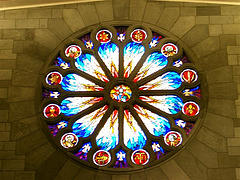 This week I engaged two separate congregations in conversations that initially appeared very different. One congregation contacted me about working with them on strategic planning. The other congregation was interested in talking about creating a multi-site regional ministry, bringing together a thriving large church with several nearby smaller congregations that appear to be failing. Central to both conversations were issues about buildings.
This week I engaged two separate congregations in conversations that initially appeared very different. One congregation contacted me about working with them on strategic planning. The other congregation was interested in talking about creating a multi-site regional ministry, bringing together a thriving large church with several nearby smaller congregations that appear to be failing. Central to both conversations were issues about buildings.
The first congregation, the one focused on planning, is in the midst of a significant zoning argument with community leaders about their proposed plans for building a family/community center. The immediate neighborhood doesn’t want this building that the congregation intends to use to serve the larger community. The congregation has been trying to birth this new location for thirty years and has already invested significant sweat equity in bringing the plans to fruition. The congregation is divided about whether the building plan is a good idea or not, and leadership is having a hard time keeping congregational mission at the core of the conversation.
The second congregation (focusing on the regional ministry concept) is struggling with how to think about the usage of buildings that are already owned by several merging congregations. Is there something about the “soul of place” attached to these locations that needs to be preserved in the usage of the buildings, or should the buildings be sold and the assets used to better resource the new Regional ministry. And what happens when the buildings are not owned by the congregations, but are owned by the denomination. Who has a right to make decisions about the future of these sacred spaces?
(Very coincidentally, both the planning congregation and the congregation planning a regional ministry happen to share a property line. They are next door neighbors. Both are large congregations. One is Episcopal and the other is Presbyterian.)
At the heart of both conversations are questions and themes about building usage, community needs and sacred space:
- What is the relationship between congregations and buildings going to look like in the next decade of church life?
- Will large campuses and building structures continue to be foundational to life and ministry in the large church, or will the large church become more about taking ministry out into neighborhoods, making use of smaller building units strategically located to meet local demographic needs?
- How do you keep conversations about buildings focused on the right kinds of questions, so that the conversation is primarily about mission and only secondarily about the buildings that make the ministry possible?
- Does space have a soul? Is there something inherent in the very space itself that must be tended in decision making about buildings?
As I ponder these questions, and try to help these congregational leaders frame the right questions, I am reminded of a helpful resource that was published by the Indianapolis Center for Congregations. The name of the book is Holy Places: Matching Sacred Space with Mission and Message by Nancy DeMott, Tim Shapiro, and Brent Bill. The book introduces a 3 pronged approach to decision making about buildings and space; discernment, deciding, doing. If your congregation is engaged in conversations about building usage, I’d highly recommend this text.
Photo Credit: Br3enda’s



